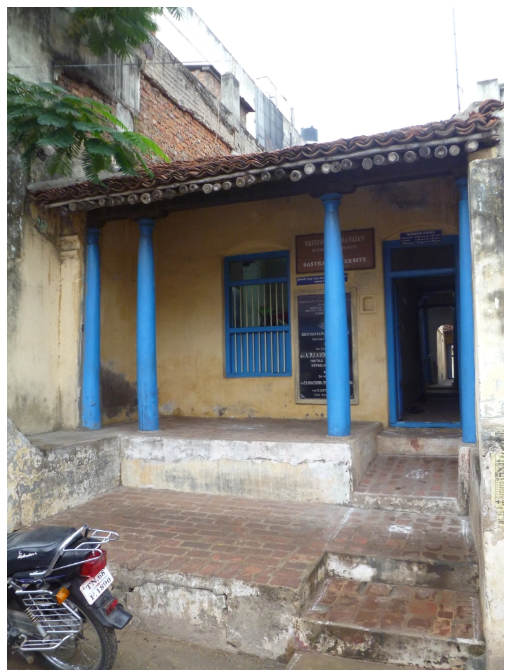6. Mathematics of computing
6.3. Srinivasa Ramanujan

Figure 1: Srinivasa Ramanujan.
Source: Wikimedia Commons (2024)
Downloadable teaching resource
Overview
A great mathematician from India with an ongoing influence in computing.
Background
Ramanujan was born in 1887 in Tamil Nadu, India and died in 1920. He began with isolated self-learning and research in mathematics while enduring periods of poverty. He attended college but neglected subjects other than mathematics, which challenged his academic progression. Despite lacking formal education, he became respected in mathematical circles for his work. He finally obtained a scholarship to the University of Madras and later attended Trinity College, Cambridge with the support of mathematician Godfrey Hardy (O'Connor and Robertson, 1998).
Explore further
Narayanan (2019) provides a blog post describing Ramanujan's life with a visual focus on places where he has stayed or visited. Some images are reproduced below.

Figure 2: Ramanujan's house in
Kumbakonam (from Narayanan, 2019)

Figure 3: Ramanujan's first residence in London, now an embassy (from Narayanan, 2019)
Contributions
Ramanujan made major contributions to mathematics, notably in the analytical theory of numbers, elliptic functions, continued fractions and infinite series. These included proofs and solutions not previously achieved in mathematics (Krishnachandran, 2021).
Ramanujan's mathematical legacy is inspirational for computing. Krishnachandran (2021) pays tribute to Ramanujan's influence, discussing computing the value of pi (π), 'Ramanujan graphs' contributing to network theory, random number generation, hash functions, and digital signal processing. The concept of the ' Ramanujan machine' is presented below.
Feature: The Ramanujan machine
The Ramanujan machine is a conceptual machine rather than being actually built. Ramanujan was known for presenting his ideas in the form of 'conjectures', which are often later proved true. He was therefore called the 'conjecture machine', inspiring the concept of a 'Ramanujan machine' (as discussed in Krishnachandran, 2021).
The current application of the machine is relatively specialised, for example with algorithms computing "probable infinite continued fraction expansions of the constants e and π" (Krishnachandran, 2021). The essential idea is to develop new mathematical formulae through the generation of multiple conjectures for testing (RamanujanMachine.com, no date).
Optional activity
Explore an implementation of the Ramanujan machine at ramanujanmachine.com. You can use your personal computing power to discover new conjectures, submit mathematical proofs or code algorithms.
See also
The Ramanujan Journal is dedicated to mathematics as influenced by Ramanujan (see Springer Nature, 2025).
National Mathematics Day is celebrated annually on December 22 in in India, marking the birthday of Ramanujan (MSN, no date)
References and further reading
Krishnachandran, V. N. (2021) Ramanujan in Computing Technology. Available at: https://doi.org/10.48550/arxiv.2103.09654 (Accessed 18 January 2025)
MSN (no date) National Mathematics Day 2024: Celebrating the Legacy of Srinivasa Ramanujan - Date, History & Significance. Available at: https://www.msn.com/en-in/education-and-learning/general/national-mathematics-day-2024-celebrating-the-legacy-of-srinivasa-ramanujan-date-history-significance/ar-AA1wiEYL (Accessed 27 January 2025)
Narayanan, P. (2019) My Mathematical Muse: A Journey into the Life of Srinivasa Ramanujan. Available at: https://thecrookedpencil.wordpress.com/2019/12/22/my-mathematical-muse-a-journey-into-the-life-of-srinivasa-ramanujan/ (Accessed 27 January 2025)
Narayanan, P. and Gade, S. (2020) Srinivasa Ramanujan: Friend of Numbers (English). Available at: https://www.tulikabooks.com/picture-books/srinivasa-ramanujan-friend-of-numbers-english.html (Accessed 17 March 2025)
O'Connor, J. J. and Robertson, E. F. (1998) Srinivasa Aiyangar Ramanujan. Available at: https://mathshistory.st-andrews.ac.uk/Biographies/Ramanujan (Accessed 18 January 2025)
RamanujanMachine.com (no date). Welcome - The Ramanujan Machine. Available at: https://www.ramanujanmachine.com/ (Accessed 18 January 2025)
Springer Nature (2025) The Ramanujan Journal. Available at: https://link.springer.com/journal/11139 (Accessed 18 February 2025)
Wikimedia Commons (2024) File:Srinivasa Ramanujan-Add. MS a94 version2 (cropped).jpg. Available at: https://commons.wikimedia.org/wiki/File:Srinivasa_Ramanujan-Add._MS_a94_version2_(cropped).jpg (Accessed 18 January 2025)
